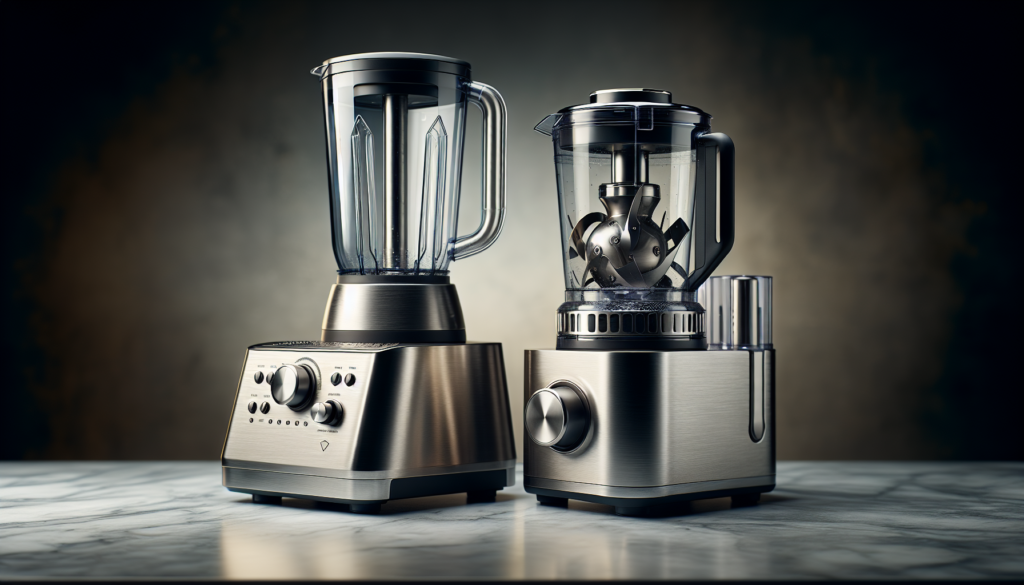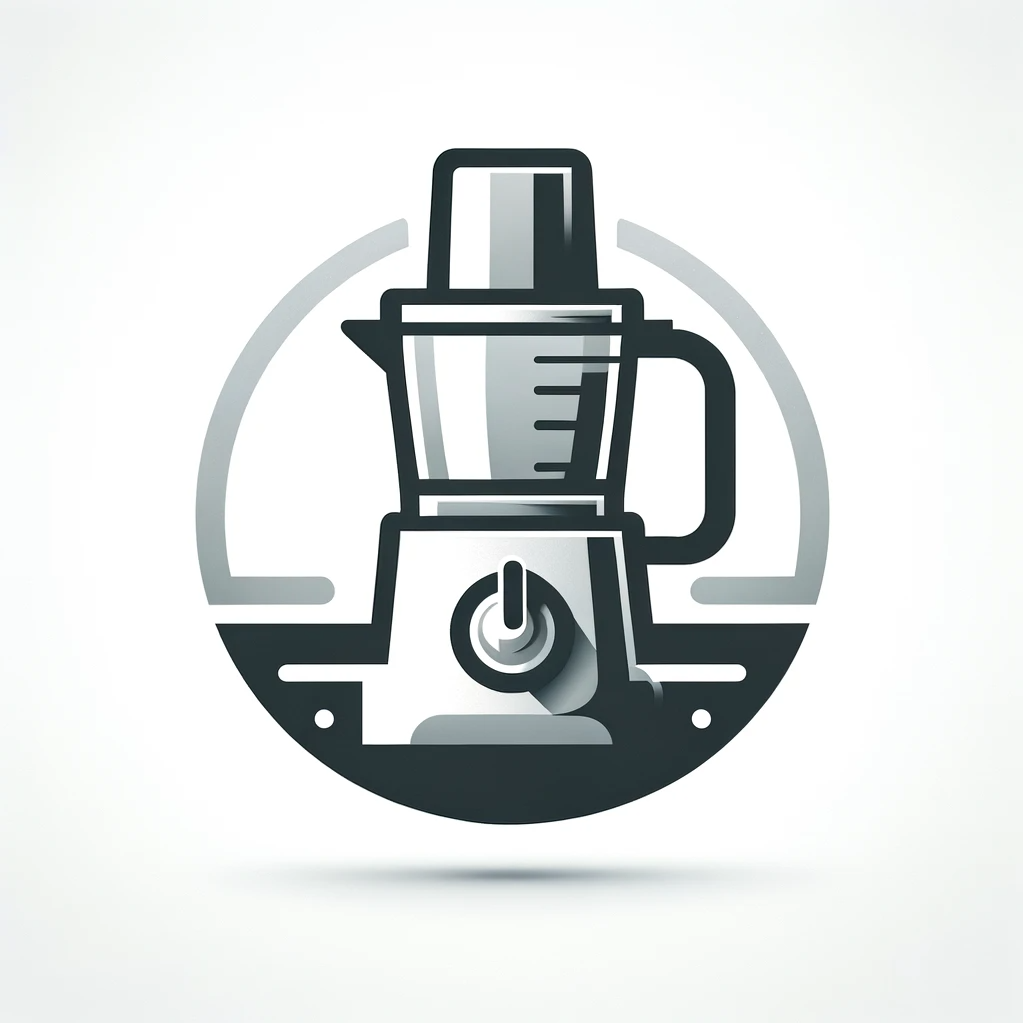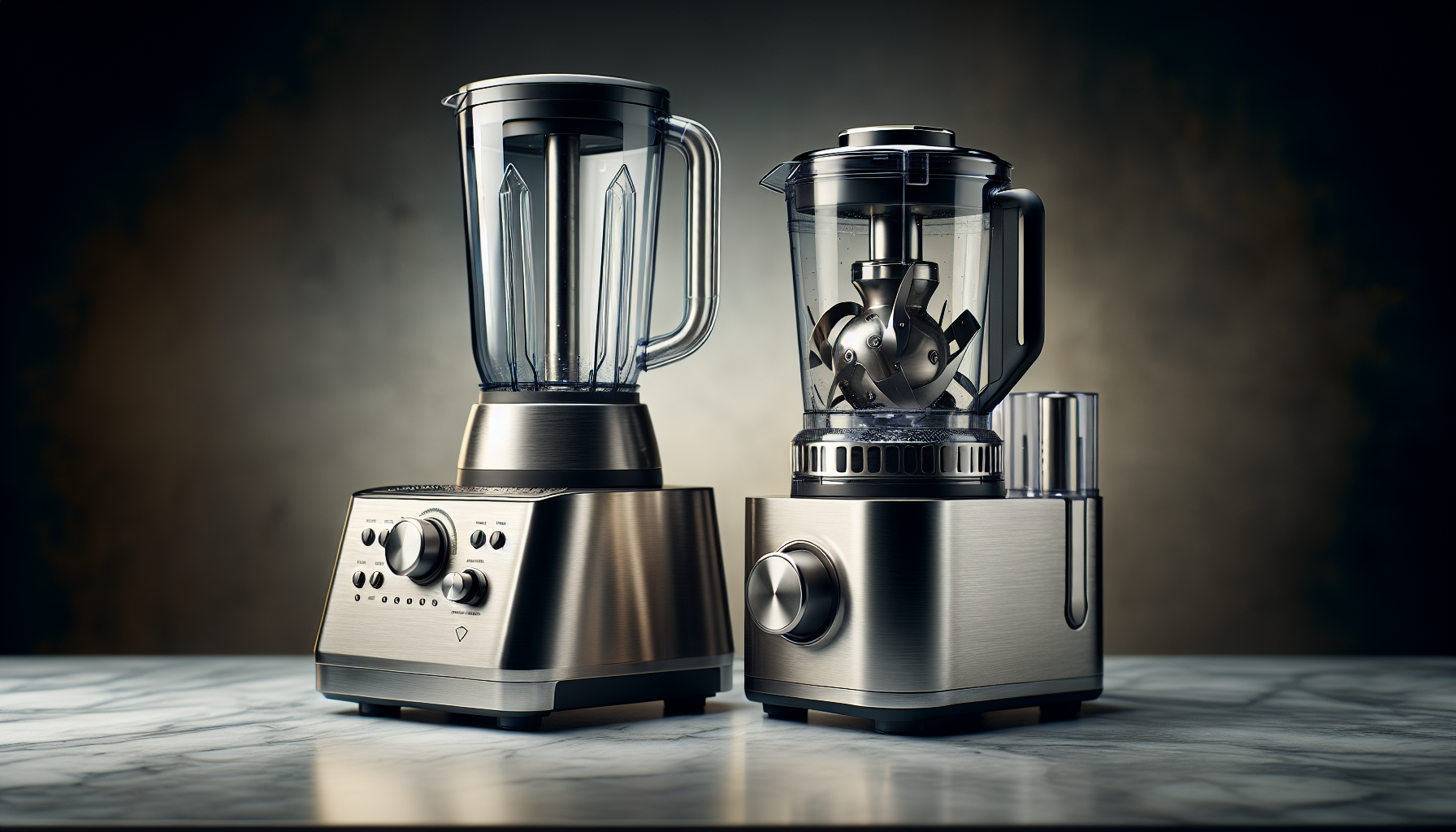If you’ve ever found yourself in the middle of a recipe, needing a food processor and realizing you don’t have one, don’t fret! You may be surprised to learn that your trusty blender could come to the rescue. While blenders and food processors are not exactly the same, they do share some similarities in terms of the tasks they can handle. In this article, we will explore whether or not you can use a blender as a food processor, and if so, what tasks it can effectively accomplish. So, before you run out to buy a new appliance, let’s see if your blender can do double duty in the kitchen!

CHECK OUT FOOD PROCESSORS AND VEGETABLE CHOPPERS ON AMAZON
Can I Use a Blender as a Food Processor?
Blenders and food processors are two essential kitchen appliances that can greatly simplify your cooking and food preparation tasks. But can a blender be used as a food processor? In this article, we will explore the similarities and differences between blenders and food processors, discuss if a blender can replace a food processor, and provide tips on using a blender as a food processor effectively.
Blender vs. Food Processor: What’s the Difference?
Before diving into whether a blender can be used as a food processor, let’s first understand the basic differences between these two appliances.
Functionality of a Blender
Blenders are primarily designed for liquid-based tasks such as blending, pureeing, and making smoothies. They have a narrow and tall jar with a blade assembly at the bottom. This design allows blenders to efficiently mix and pulverize ingredients into a smooth consistency.
Functionality of a Food Processor
On the other hand, food processors are more versatile and excel at handling solid food preparation tasks. They come with various attachments and functionalities, such as chopping, slicing, grating, and kneading dough. The wide and shallow bowl of a food processor allows for more precise control and uniformity in processing ingredients.
Key Differences Between Blenders and Food Processors
The main differences between blenders and food processors lie in their design, speed, power, attachments, and multiple functions. Blenders have a narrow and tall jar, while food processors have a wide and shallow bowl. Blenders typically operate at higher speeds and have more powerful motors compared to food processors. Food processors, however, offer a range of attachments and accessories, allowing them to perform multiple functions beyond just blending or pureeing.
Similarities Between Blenders and Food Processors
While blenders and food processors have notable differences, they also share several similarities in terms of their capabilities. Let’s explore these similarities.
Both Can Blend and Puree
Both blenders and food processors are capable of blending and pureeing ingredients. Whether you’re making a smoothie, soup, or sauce, both appliances can effectively break down ingredients into a smooth consistency. The sharp blades and powerful motors in both devices ensure thorough blending and pureeing.
Both Have Blades and a Motor
Blenders and food processors function by rotating blades powered by a motor. These sharp blades are designed to efficiently chop, blend, or puree ingredients. The powerful motors in both appliances provide the necessary torque to drive the blades and process ingredients effectively.
Both Can Handle Some Similar Ingredients
Blenders and food processors can handle similar ingredients, especially when it comes to liquids, soft fruits, and vegetables. Both appliances can easily handle tasks such as making smoothies, pureeing soups, or creating creamy sauces. However, food processors have an edge when it comes to processing solid foods, such as chopping nuts or shredding cheese.
Differences Between Blenders and Food Processors
While there are similarities between blenders and food processors, the differences are crucial to consider when deciding whether a blender can replace a food processor.
Design and Bowl Shape
One of the primary differences between blenders and food processors lies in their design and bowl shape. Blenders typically have a narrow and tall jar, which is ideal for blending liquids. Food processors, on the other hand, have a wider and shallower bowl. This design allows for better control and consistency when processing solid ingredients.
Speed and Power
Blenders are known for their high-speed blending capabilities. They often have powerful motors that can reach high speeds, allowing for quick and efficient blending and pureeing. Food processors, while not as fast as blenders, offer a wider range of speeds that can be adjusted according to the processing task at hand.
Attachments and Accessories
Food processors have a clear advantage when it comes to attachments and accessories. They typically come with a range of blades and discs that can be interchanged for various functions such as slicing, shredding, grating, or kneading dough. Blenders, on the other hand, may have limited attachments available in the market, although some models do offer interchangeable blades or food processor attachments.
Multiple Functions
While blenders primarily excel at blending and pureeing, food processors offer a multitude of functions beyond just blending. With the appropriate attachment, food processors can chop, slice, grate, shred, and even knead dough. This versatility makes a food processor a more suitable choice for tasks that go beyond simple blending or pureeing.
Can a Blender Replace a Food Processor?
Now, the question arises: Can a blender replace a food processor? The answer depends on the specific task you want to perform and the level of precision and control required.
Limitations of Blenders
Blenders have some limitations when it comes to more intricate food processing tasks. Due to their tall and narrow design, blenders may struggle with evenly chopping or slicing certain ingredients. Moreover, blenders may not have the necessary attachments or specialized blades to perform functions like shredding or grating.
Suitability for Different Tasks
Blenders are ideal for tasks such as blending smoothies, pureeing soups, or making creamy sauces. They excel at creating a uniform and smooth consistency. However, when it comes to chopping, slicing, or shredding solid ingredients, a food processor provides better results due to its wider bowl and specialized attachments.
When a Blender Can Be Used as a Food Processor
While a blender may not fully replace a food processor, there are certain situations where it can be used as a makeshift food processor. If you’re looking to chop or puree softer ingredients like fruits, vegetables, or cooked meat, a blender can be a viable option. Additionally, some blenders offer attachments or blades specifically designed for food processing tasks, allowing for a more versatile use of the appliance.
Using a Blender for Chopping and Pureeing
Chopping
When it comes to chopping ingredients, blenders can be used for softer foods. For example, you can easily chop onions, garlic, or herbs in a blender. However, it is essential to cut the ingredients into smaller pieces before adding them to the blender to ensure even chopping. Pulse the blender several times until you achieve the desired chop size, being careful not to over-blend and turn the ingredients into a puree.
Pureeing
Blenders are excellent for pureeing ingredients, particularly when it comes to making smoothies or soups. Simply add your desired ingredients to the blender, such as fruits, vegetables, and liquids, and blend until you have a smooth and consistent texture. Blenders with high-speed settings will ensure a thorough pureeing process.
Blender Techniques for Chopping and Pureeing
When using a blender for chopping or pureeing, it’s important to use the pulse function or blend in short bursts. This technique helps achieve a more controlled and precise chopping or pureeing result. It’s also crucial to scrape down the sides of the blender jar intermittently to ensure all the ingredients are evenly processed.
Limitations and Tips
While blenders can be used for chopping and pureeing to an extent, they do have limitations. Blenders may struggle with chopping tougher or fibrous ingredients like carrots or celery. For more consistent and precise results, consider using a food processor. It’s also important to avoid overfilling the blender jar when chopping or pureeing, as this can lead to uneven processing or spills. Start with smaller batches and add more as necessary.
Using a Blender for Shredding and Slicing
Shredding
Shredding involves turning larger foods like cheese, vegetables, or meat into smaller, shredded pieces. While blenders are not specifically designed for shredding tasks, they can still be used for softer ingredients. Cut the ingredients into smaller, manageable pieces and add them to the blender. Pulse the blender until the ingredients are shredded to your desired consistency. Keep in mind that blenders may not achieve the same uniformity as a dedicated food processor or shredder attachment.
Slicing
Slicing involves cutting foods into thin, even slices. Blenders are not typically designed for slicing tasks, as their blades are positioned at the bottom and may not provide the necessary control for precise slicing. It is recommended to use a sharp knife or a dedicated slicer for precise slicing tasks.
Blender Techniques for Shredding and Slicing
When using a blender for shredding, it’s important to cut the ingredients into smaller pieces before blending. This will ensure more effective shredding. For slicing, it’s best to rely on other kitchen tools like knives or mandolines to achieve the desired thin slices.
Limitations and Tips
While blenders can be used for shredding softer ingredients, they may not produce the same consistent or uniform results as a dedicated shredder attachment or food processor. If you frequently require shredded or sliced ingredients, investing in a food processor or a shredder attachment will yield better results. Additionally, ensure that the blender jar is not overfilled, as this can hinder the shredding or slicing process.
Using a Blender for Dough and Batters
Making Dough
Making dough in a blender can be possible for certain types of dough, primarily those that require minimal gluten development. For example, you can make pie crust dough, quick bread dough, or certain cookie doughs in a blender. Start by adding the dry ingredients to the blender, followed by the fat (such as butter or shortening), and cold liquid. Pulse the blender until the dough comes together. Be cautious not to over-blend, as this can result in a tough dough due to excess gluten development.
Preparing Batters
Blenders are excellent for preparing batters for pancakes, crepes, waffles, or other batter-based recipes. Simply add the required ingredients to the blender jar, such as flour, eggs, milk or buttermilk, and any additional flavorings. Blend the ingredients until a smooth batter is formed, ensuring all the ingredients are thoroughly combined.
Blender Techniques for Dough and Batters
When making dough or batters in a blender, it’s important to use the pulse function or blend in short bursts. This technique helps incorporate the ingredients evenly and prevents over-blending. Additionally, scrape down the sides of the blender jar periodically to ensure all the ingredients are fully mixed.
Limitations and Tips
While blenders can be used for certain dough and batter preparations, they may not be suitable for all types of dough. Blenders are not designed to handle high gluten development required for bread dough, which involves kneading. For more complex dough recipes, it’s best to rely on traditional mixing methods or use a stand mixer. When using a blender, ensure the jar is not overfilled, as the ingredients may not mix evenly or may spill out during blending.
CHECK OUT FOOD PROCESSORS AND VEGETABLE CHOPPERS ON AMAZON
Blenders with Food Processor Attachments
If you’re looking to have the functionalities of both a blender and a food processor in a single appliance, there are blenders available with interchangeable blades and attachments that can serve as a makeshift food processor.
Blenders with Interchangeable Blades and Attachments
Some blenders come with interchangeable blades and attachments specially designed for various food processing tasks. These attachments can include slicing discs, shredding discs, or chopping blades. By switching out the blender blade assembly with the appropriate attachment, you can expand the functionality of the blender and use it as a food processor.
Benefits of Blender-Food Processor Combo
The main benefit of having a blender with food processor attachments is the space-saving aspect. Instead of having two separate appliances on your kitchen countertop, you can have a single appliance that can perform both blending and food processing tasks. This can be especially advantageous if you have limited storage space in your kitchen.
Popular Blender Models with Food Processor Attachments
Many renowned blender brands offer models that come with a food processor attachment or include separate food processing containers. These models often have the power and speed necessary for food processing tasks while maintaining their high-performance blending capabilities. Some popular blender models with food processor attachments include the Ninja Foodi Power Pitcher System, the Vitamix 5200 with a food processor attachment, and the Breville Boss To Go Sport with a separate food processing container.
Conclusion
While a blender can be a valuable tool in the kitchen, it cannot completely replace a dedicated food processor. Blenders excel at tasks such as blending, pureeing, and making smoothies, but they may have limitations when it comes to more intricate food processing tasks like chopping, shredding, or slicing. However, with some modifications, using a blender as a food processor for certain tasks is possible. When deciding whether to use a blender or invest in a separate food processor, consider the specific tasks you need to accomplish and the level of precision and versatility required. By understanding the differences between blenders and food processors and following the tips provided, you can make the most out of your blender as a food processor and enhance your culinary creations.

